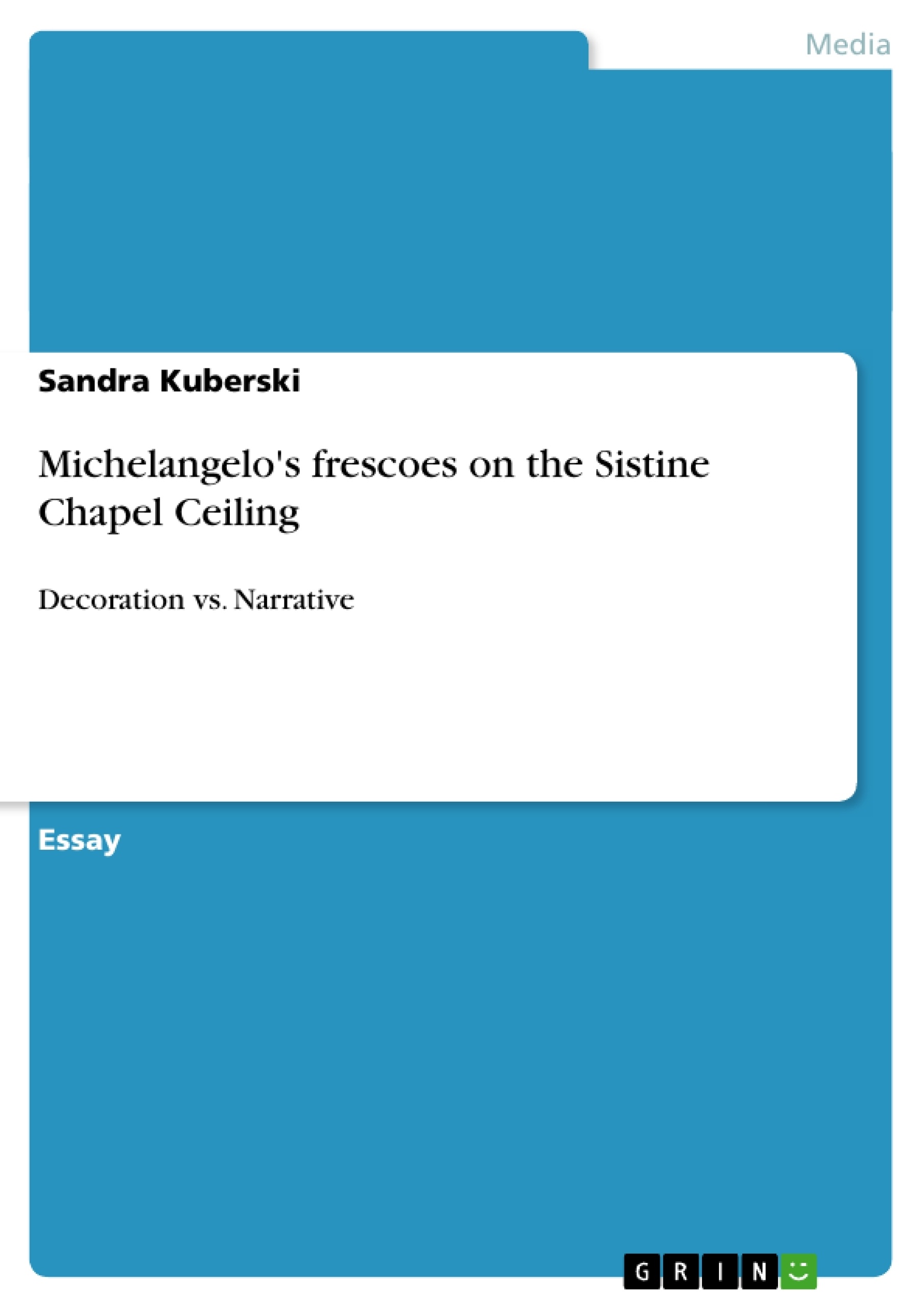In 1508 Michelangelo began with his working on the ceiling of the Sistine Chapel, he completed it four years later. His frescoes show stories of the Old Testament about creation and fall of humankind and give an anticipation of salvation through Christ. Michelangelo at first did not want to paint the ceiling because he saw himself as sculptor and thought of the commission as trap of his rivals. Moreover, it was unusual for ceiling frescoes to show narration, they were in general regarded as minor compared to walls. Michelangelo, undeniably, taught art history better, his artwork became a masterpiece of High Renaissance. This essay is going to examine Michelangelo’s concerns in decorating the ceiling, especially in regard to the representation of narration and how successful his attempts were.
Narrative on the Sistine Chapel Ceiling
In 1508 Michelangelo began with his working on the ceiling of the Sistine Chapel, he completed it four years later.[1] His frescoes show stories of the Old Testament about creation and fall of humankind and give an anticipation of salvation through Christ. Michelangelo at first did not want to paint the ceiling because he saw himself as sculptor and thought of the commission as trap of his rivals.[2] Moreover, it was unusual for ceiling frescoes to show narration, they were in general regarded as minor compared to walls. Michelangelo, undeniably, taught art history better, his artwork became a masterpiece of High Renaissance. This essay is going to examine Michelangelo’s concerns in decorating the ceiling, especially in regard to the representation of narration and how successful his attempts were.
The structure of the ceiling is divided into various subsets: the centre is taken in by nine narrative scenes from the Book of Genesis, which are framed by illusionary architecture and nudes sitting on blocks of marble. The second zone is dominated by the monumental depictions of prophets and sibyls on stone thrones, framed by two pairs of small putti on each side, who seem to support the blocks above them like caryatids. Between the thrones are triangular spandrels with pointed arches, showing ancestors of Christ. Beneath them in lunettes are more ancestors. Above them in the entablature are so-called ignudi, male nudes, who appear as statues who came to life, „stretching, twisting and turning in a collective display of grace and elegance”[3]. In each of the four corners is a further spandrel which shows scenes from the Old Testament.
The main narrative in the centre of the ceiling consists of nine frescoes, which can be divided into three triads, the first showing the creation of the earth, the second creation of humanity as well as its fall from grace and the third the struggle of the humans on earth, including their final fall and sins. The size of the frescoes alternates, a small one follows upon a large one, overall there are four large and five small ones.
The first large fresco depicts the “Creation of Sun and Moon” and of the plants. The Genesis in general is not very detailed, which gives the artist a great freedom of which elements he wants to unify. God, in this depiction, is depicted two times, at one point seen from the front, accompanied by some infants, at the other from behind. In this “continuous style” (after F. Wickhoff), the events within the picture ‘flow’ into each other, showing an action over a longer period of time within a single image.
The large Creation scene is flanked by two smaller ones, the “Separation of Light from Darkness” and the “Congregation of the Waters”. Similarly, both depict the creation in a very dynamic and physical way, God’s arms are lifted as he literally splits the background into two halves, a pure black one and the other cloudily white. God seems to be in the action of turning around, swimming through the dark sky whilst creating light, his robe swirling round his body and also the white clouds behind him seem to be moving.
The first triad explains how the viewer should read the cycle: each of the triads has to be read as unity, each single fresco informs upon the other two. In conclusion, we see God busy flying around, creating the world, from different sides, like a sculpture. This multiperspectivity is an approach which might come from Michelangelo’s background as sculptor, before the ceiling he did not see himself as painter. The Genesis narrative is reversed when read from the entrance of the chapel, but as the first sight after entering the chapel would naturally turn to the altar and the up, Michelangelo directs the sight of the viewer in a logical way. Moreover, the figures in the first scenes are much larger than the ones in the more crowded scenes at the end, which are also closer to the entering viewer.[4]
[...]
[1] cf. Hughes, Anthony, Michelangelo (London: Phaidon Press, 1997, p. 127f).
[2] cf. Gilbert, Creighton, Michelangelo: on and off the Sistine ceiling (New York: George Braziller, 1994, p. 32).
[3] Graham-Dixon, Andrew, Michelangelo and the Sistine Chapel (London: Weidenfeld & Nicolson, 2008, p. 133).
[4] cf. Partridge, Loren, Michelangelo: the Sistine Chapel ceiling (New York: George Braziller, 1996, p.27).
- Quote paper
- Sandra Kuberski (Author), 2012, Michelangelo's frescoes on the Sistine Chapel Ceiling, Munich, GRIN Verlag, https://www.grin.com/document/286026
-

-

-

-
Upload your own papers! Earn money and win an iPhone X. -

-
Upload your own papers! Earn money and win an iPhone X. -

-
Upload your own papers! Earn money and win an iPhone X. -

-
Upload your own papers! Earn money and win an iPhone X. -

-
Upload your own papers! Earn money and win an iPhone X.

